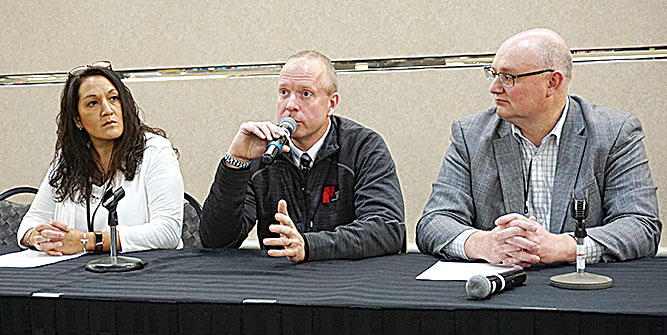Schools struggle to keep up with building needs

Jill Schramm/MDN Steve Holen with McKenzie County Public Schools speaks on a panel as panelists Leslie Bieber of Alexander Public School, left, and Brandt Dick of Underwood Public School, right, listen.
Williston’s new fire hall has a modern kitchen, while food must either be delivered or cooked on a hot plate for students at one of the city’s elementary schools for lack of a kitchen.
“When a city decides to build a fire hall, they don’t need 60% of the district to vote,” said Alexander Public School Supt. Leslie Bieber. “They don’t have to ask permission. Whereas we do.”
The Williston example was cited at the Western Dakota Energy Association conference in Minot Thursday during a panel discussion that highlighted the challenges in funding school buildings.
The difficulty in passing bond issues to maintain and upgrade the state’s school buildings to meet codes and accommodate enrollment growth was a concern of a panel of three superintendents and a Williston legislator.
“The ability to pass a bond has become an issue statewide,” said panel moderator Aimee Copas, executive director of the North Dakota Council of Educational Leaders. “School leaders and communities are struggling with this from corner to corner – north, south, east and west – around our state.”
In North Dakota, 48 districts don’t even have a building fund, she said.
“So we have districts all over the state that are dealing with overcrowding issues – sometimes districts that are dealing with buildings that are 50 to 80 years old that they’re trying to keep afloat,” she said. “They’re really struggling with getting to the 60% supermajority.”
Garrison was cited as an example of a school district that has gone to voters multiple times and never quite reached a 60% majority.
Senate Majority Leader Rich Wardner, who also spoke separately at the conference, said public misperception that the state is flush with cash and should pay for school buildings is causing school bonding votes to fail.
“I would be surprised if there’s any bond issues passed in the next year or two,” he said, “unless there’s some really fired-up patrons who want to get it done.”
Wardner said he plans to work with school officials and legislators to come up with a proposal in the 2021 session to address concerns with the way the state funds education.
Educators on Thursday’s panel voiced concerns about the way the state treats oil- and gas-producing districts, which makes it difficult for them to fund needed projects. They spoke about being unable to save for construction because money in the bank results in a deduction from state aid.
“For a school district, it’s a little bit like running uphill on an icy plane,” Copas said. “Most districts are never allowed to have, according to law, more than three months of operating expenses at any point in time in their bank account. I don’t know very many businesses that are able to pull that off. So I’m always amazed, in wonderment, at our 170 superintendents in the state – that they can do that and keep their businesses afloat.”
Supt. Steve Holen with McKenzie County Public School in Watford City said districts in oil country face additional difficulty in generating revenue because 75% of oil and gas taxes received in lieu of property tax are deducted from their state per pupil aid. A recent legislative change now allows districts to keep a bit more of their oil and gas taxes to help pay off bonds. But oil- and gas-producing districts remain shorted in the state’s effort to maintain equity with non-producing districts, said Holen, who suggested adequacy rather than equity be the focus of state aid.
Rep. David Richter, R-Williston, said rather than subtracting the oil and gas taxes from state aid, it should be included in the accounting of local dollars districts are providing for education. The current accounting leaves schools in oil country unable to achieve the 60 mills of local support the state expects, he said.
“We have to keep in mind that ‘in lieu of’ means local property tax, and it includes oil, gas, coal, wind, any kind aof energy that’s produced,” he said.
Bieber said school buildings need to be seen as essential infrastructure in the state.
“When you want that workforce to settle into your community, that’s one of the first things that they look at is our schools,” she said. “We have to keep those infrastructures up to date so we’re not overcrowding, so we don’t have to steal from Peter to pay Paul to pay for our buildings, so we can continue to provide that wonderful education that does attract your workforce out here into our communities. So, to me, a huge part of it is if people would really begin to view a school not as so much as a separate entity, but as a part of our infrastructure.”
Richter said he’s had a tough time persuading other legislators that school properties are infrastructure, but he sees ground being gained.
“We just need to keep working on convincing legislators that they are infrastructure. I think there’s a base there now. There are a number of legislators who believe that. We just need to keep working on it,” he said.


